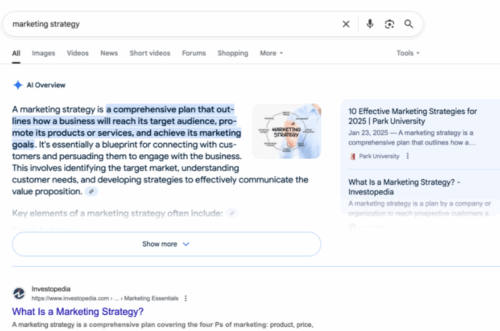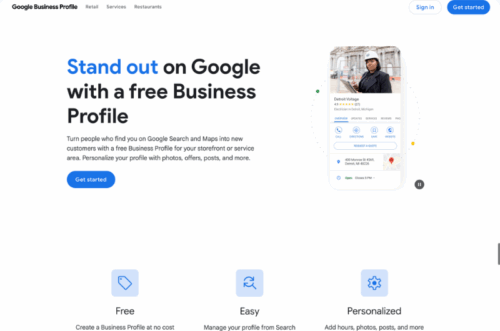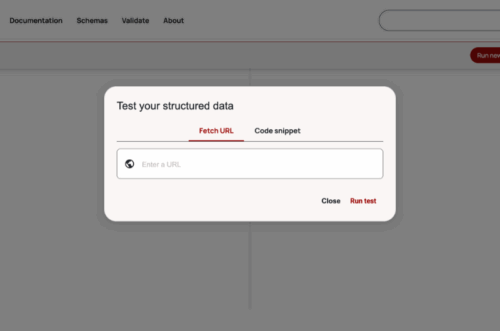
Facing a zero-click marketing world
The state of SEO and content marketing has changed dramatically, driven by search engine algorithm updates and the rise of AI search tools. And it looks like these changes will directly impact how marketers approach visibility, engagement, and content strategy across search and digital platforms.
In 2024, at least 60% of Google searches were answered without users clicking through to a single website.
AI search tools, like ChatGPT, have drawn users away from the typical search engines, summarising content directly from websites. This means your content needs to be structured and clear enough to be included in AI-generated responses, even if no one clicks through.
“At B2B commerce SaaS firm Commercetools, CMO Jen Jones told Digiday that the company’s click-through-rate (CTR) had declined 20% from November 2024 owing to Google’s AI Overviews (the firm rolled out a core update that month).”
Social media platforms are giving up to 10x more views to posts without a link as well.
As a result of these changes, you may notice less traffic to your website or landing page, and more issues tracking Marketing Influenced Revenue and Lead Sources. Ultimately, it makes attribution considerably harder, almost like getting in a time machine and going back to the 2000s.
We may need to rethink the strategy, audit our content and SEO, and make sure our website is set up to compete in the world of zero-click marketing.
This is what I suggest needs to be done, mostly focusing on Google, as it still receives approx 90% of the world’s internet searches:
1. Optimise for Snippets and Overviews

Google’s algorithm doesn’t just rank your website content, it also evaluates whether it qualifies for a “Featured Snippet”, “AI Overview”, or a “People also ask” box. These are located near the top of the search browser.
To improve your chances of showing in the snippets for your keywords, avoid jargon, and focus on publishing clear, direct language:
- Use question-based content in H2 font, starting with “why…” or “can…”
- Front-load concise, direct answers up to 50 words long
- Use lists, bullet points, and tables
Optimising your content will also increase your chance of being picked up by AI tools like ChatGPT and Perplexity.
2. Utilise branded search

Brand is back baby! We need to build a strong brand presence and engagement more than ever before. Even if branded search results don’t lead to a click, they still matter, and can be incredibly valuable for visibility and trust.
- Claim and optimise your Google Business Profile
- Ensure consistent business name, address, and phone number across your website and social media profiles
- Use schema markup to surface your brand info more clearly
- Link all your social profiles from your website and vice versa
- Have a clear, up-to-date “About” page on your website
- Track brand search volume with tools like Google Search Console, Ahrefs, or Semrush
3. Add Schema Markup to your website

Schema markup, or structured data, is code you add to your web pages to help search engines better understand your content. It doesn’t change what users see, but it gives Google extra context behind the scenes.
When implemented correctly, schema markup makes your content eligible for rich results. These are enhanced search listings that stand out visually and often answer the query directly on the results page, such as FAQs, star ratings, product specs, or step-by-step instructions.
This helps Google surface your content as a rich result, even without a click.
Schema markup also improves the way AI models interpret and categorise your content, especially in tools that generate answers using structured sources.
The main types are:
- FAQ schema – Turns your page into an expandable list of questions and answers in search results
- HowTo schema – Breaks down step-by-step instructions with visuals
- Article schema – Adds metadata like headline, author, and date to help qualify for Top Stories and rich previews
- Product schema – Adds price, availability, and reviews to product listings
- LocalBusiness or Organisation schema – Reinforces your brand presence in branded search results
4. Create visual content
In zero-click search results, visual elements like image packs, video previews, infographics, and charts often take priority. This is especially true for how-to queries, product searches, and trending topics.
These visual formats can appear above traditional text links, capturing attention and trust even without a click.
- Create content designed to rank visually – Use original images (if possible), infographics, charts, and short videos that directly support your topic. Avoid generic stock photos when possible
- Optimise images properly – Use descriptive, keyword-rich file names (eg. how-to-choose-a-saas-software.jpg instead of IMG001.jpg) and add clear, useful alt text
- Add schema markup for images and video – Use structured data, like ImageObject, VideoObject, or HowTo, to help Google pull your media into visual SERPs
- Embed videos on key pages – If you’re explaining a process or demonstrating a product, a short, embedded video can boost time-on-page and get picked up in video carousels or previews
5. Own Local and Voice Search
Local and voice searches are important for businesses with a physical location that customers may visit.
Searches are normally for things like business hours, directions, or quick answers provided by voice assistants. While these searches may not generate clicks, they can still drive real-world actions such as store visits, calls, or bookings.
- Keep your Google Business Profile updated– Make sure your business hours, location, services, and contact details are accurate. Add photos, respond to reviews, and post updates regularly
- Optimise for voice search – These tend to be more conversational and question-based. Create FAQ content and use natural language to answer common questions clearly and concisely. Short, direct answers work best for smart assistants and featured snippets
The rise of zero-click marketing, and now AI-powered search, does not mean the end of SEO. It means we need to adapt. Visibility, not just traffic, is the new battleground. That means showing up in featured snippets, owning branded searches, and making your content work harder.
If you are not getting the clicks, make sure you are still getting seen, remembered, and trusted. The brands that succeed in a zero-click world are the ones that stop chasing visits and start owning the search experience.
The rules have changed. It is time your strategy changed too.







